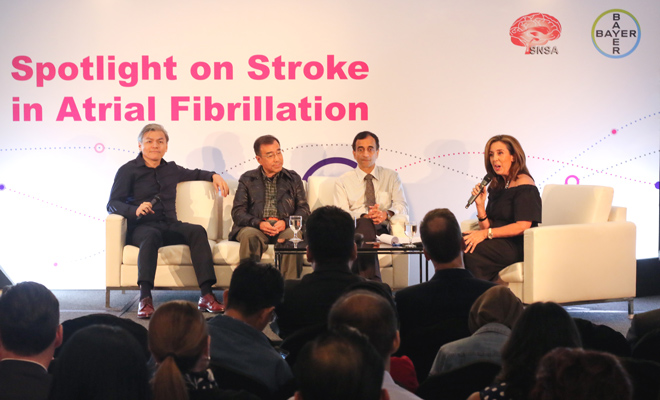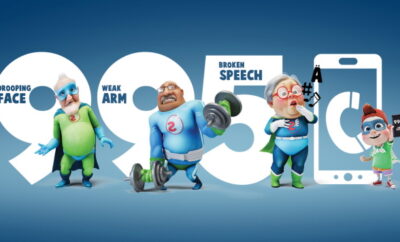
Health x Wellness
Are NOACs the Best Way to Prevent Stroke Caused by Atrial Fibrillation?
Atrial Fibrillation (AF) is a condition that becomes more prevalent with age, and with an ageing population imminent, it is a cause for concern.
What’s more, AF is the most common heart rhythm disorder in Singapore. AF is a heart rhythm problem characterised by irregular heartbeats, where the heart fails to contract properly. When the heartbeat is not strong enough to pump enough blood out of the heart, blood pools within and a clot can form. When the clot breaks free and is pumped out towards the brain, it can get stuck in a blood vessel and cause a stroke. What is of interest and concern is the fact that AF increases the risk of stroke by blood clots by five-fold, and often the effects are more severe and cause disability in over 50 percent in cases reported.
It’s possible to have AF without realising it. If symptoms do appear, they can include racing or unusual heartbeat, coupled with fatigue and dizziness. Risk factors that may lead to AF include high blood pressure, heart valve defects, diabetes, emotional and physical stress, diet and lifestyle, heart disease and advanced age.
“There are some things you cannot change to prevent AF itself. But there are some things you can do; like control blood pressure and diabetes. These are things that are actually associated with increased chances of getting AF. But once you have AF, how do we prevent stroke? Most important is actually to take anti-coagulation medication. You can also do other things like controlling hypertension as well to improve your outcome.” said Dr Tan Ru San, Senior Consultant at the National Heart Centre Singapore.
The message is pertinent simply because comparatively speaking, Singapore – and Asia in general – are behind the world when it comes to stroke prevention, which is now the predominant method of approach if the last five years are anything to go by. Between 2010 and 2015, we’ve seen a improving numbers when it comes to stroke prevention, with an increase in patients receiving anticoagulant treatment (rising from 57 percent to 71 percent), largely due to a marked increase (from 4.1 percent to 37 percent) in the use of non-vitamin K antagonist oral anticoagulants (NOACs) such as Rivaroxaban (Xarelto) and Apixaban.
A Credible Treatment
It’s early days, but studies conducted on the efficacy of NOACs have been positive so far. NOACs have been proven to be effective in Phase III clinical trials, where they compare them with the best currently available treatment – Vitamin K Antagonists (VKAs) such as Warfarin. While in a large real-world study in the US (REVISIT US study) involving 23,000 patients, Xarelto effected a 39 percent reduction in the combined endpoint of ischemic stroke (when an artery to the brain is blocked) or intracranial bleeding compared to Warfarin. In XANAP, a pan-Asian real-world study on the use of Xarelto in stroke prevention in AF patients, low rates of both stroke (1.7 percent per year) and major bleeding (1.5 percent per year) with were seen with Xarelto in routine clinical practice, a result that was consistent with Phase III clinical trials.
Dr Tan summed up the advantages of NOACs as such: “Up till recently, the standard of care was Warfarin, but those are difficult to use because individual patients require different drug doses and the doses vary with time. Some people have to take very high doses while some can take low doses; it can be due to food and drug interactions or due to intercurrent diseases. So patients, typically if they are stable, come back monthly for a checkup. If they have a disease or take new drugs, they have to see the doctor more frequently, which is inconvenient. Also, the requirements for blood monitoring is very tight, so you have to keep to a very strict and tight interval [ed: frequency of dose]. Too low, it’s not effective, too high, you bleed. Sometimes we have to monitor them very carefully and that is actually too demanding for many patients.”
As of now, international guidelines recommend NOACs as the preferred method of managing AF-associated strokes as they offer better efficacy, safety and convenience compared with older anticoagulant methods that feature VKAs. As recognition of Xarelto’s clinical effectiveness and cost-effectiveness, the Ministry of Health has recently included it in the Medication Assistance Fund (MAF), making it eligible for government subsidies. However, the importance of anticoagulation drugs and the benefits of using a NOAC over VKA is still not fully understood by the general public.
Managing Benefits and Risks
What NOACs offer is a comparatively lower risk of side effects and a bigger margin of error when it comes to administration, which are downsides of VKAs. “(However) if there are excursions which are unpredictable, sometimes it may cause bleeding,” Dr Tan adds, explaining that risks of side effects like internal bleeding are still present. Except for certain circumstances and health conditions, like kidney failure, for example, the advantages over the existing solution are plenty.
“(For the new drugs) the drug levels are more predictable so we can prescribe them at the standard dose. And we found that they have superior efficacy for preventing stroke and most importantly – the most devastating complication of older drugs – bleeding in the brain; this is very much reduced compared to Warfarin,” he adds.
Ultimately, it’s about managing the risk factors that come with AF for a better quality of life. “Compared to a person not taking anti-coagulating drugs, the risk [factor] will be increased. This comes proprietary with stroke – you must accept that there is a slight risk. Overall, compared to not taking any drugs, a patient who has AF or other risk factors, it’s better to take than not to take,” said Dr Tan.









